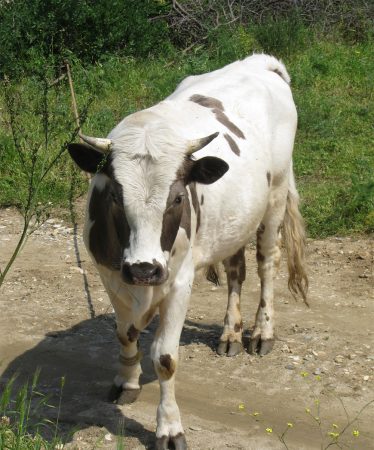LOOKING FOR WILD ASPARAGUS ON IKARIA
You have to learn how to look. That’s what my friend Lefteris, a fount of knowledge about Ikaria’s flora, told me as soon as we stepped out of the car in Cambo, the island’s largest flat plain, not too far from Evdilos, the port town in the center of the north side. He didn’t mean that I had to watch my appearance in any special way, of course, but to learn how to train my eyes on the plants around me. “When you come from the city, this takes time,” he said. “Your eyes know to look everywhere, darting around, but to focus on nothing in particular. That’s not how country folk, who live more slowly and close to nature, see.”
At my request, Lefteris and I set out that day to go wild-asparagus picking. Late April is the season when these delicate stalks, as thin as spaghetti in some cases, sprout, and Cambos is the place on the island where they flourish the most. Goats like these tender stalks, too, and I wasn’t sure if they’d have beat us to the treat.
I must admit total ignorance here. To my city-girl’s imagination, I thought asparagus sprouted like grass and that we’d just notice the stalks in plain view. That got a chuckle out of my friend.
We walked a good ten minutes up a dirt road before he spotted the first asparagus plant, all thin, spiny needles camouflaging a few dark green shoots. To get to them, we scraped our hands a bit and had to let the thorny bush puncture our knees and shins. This was tougher than I had imagined.
That morning, Lefteris and I spent about two hours collecting wild asparagus, enough stalks for two omelets at best, so slow-going is the hunt.
But after a little while, the asparagus hunt seemed really to be about something else: Observing all the other amazing plants, many edible, all around us, so long as we slowed down enough to see them. That was the lesson of the day. Here are a few pictures of what we saw on our walk up that dirt road. As for the 20 or so thin stalks of wild asparagus, the crown jewel – or aristocrat, as the Greeks say – of wild edible food in spring, we munched on them raw, savoring the sweet, grassy, crunchy stalks before even making it back to the car.
Here are a few of the plants we met on the way to searching for asparagus in the wild:
Fern tops make a delicious spring treat. In Greece, we fry or blanch them. They are delicious!
Ovries, which look a little like asparagus tips, are another amazing spring treat, found in the wild. They are a vine and are cooked the same way that wild asparagus is, either in simple omelets or blanched or pan-fried, with olive oil and a little vinegar. They are slightly bitter.
The delicate white flowers of wild garlic, which we also encountered on our walk, belie their pungent aroma and the difficulty of extracting the bulbs from several inches int he ground.
Lemon balm, also something we found on our walk, is an amazingly aromatic addition to savory phyllo pies and salads.
One of the most amazing edible wild treats and one of the rarest, are the bulbs from a particular species of hyacinth, which the Italians know as lampascioni and the Greeks as volvoi, or bulbs. The bulb can be as deep as 10 inches, one reason why these deliciously bitter treats are harder and harder to come by. But they are worth the trouble. Once blanched and brined, they make a delicious meze for ouzo. We found a few growing wild on our walk.
When we came across wild artichokes, typically in areas where wild fennel also grows (and the two are delicious when cooked together), I thought that whoever first considered trying to extract the hearts of this plant must have been either very hungry or an intrepid, if unwitting, gourmet! They’re delicious, of course.
We encountered about half a dozen other wild treats on our walk, among them several varieties of wild chicories, wild mustard greens, wild arugula, an herb called kafkalithres, wild sweet sorrel and even calendula, which is used for therapeutic purposes. We also encountered this guy, who looked most unpleased that we were scouring about his neighborhood, eating the very things that makes him both sated and, well, tasty in his own right!
















